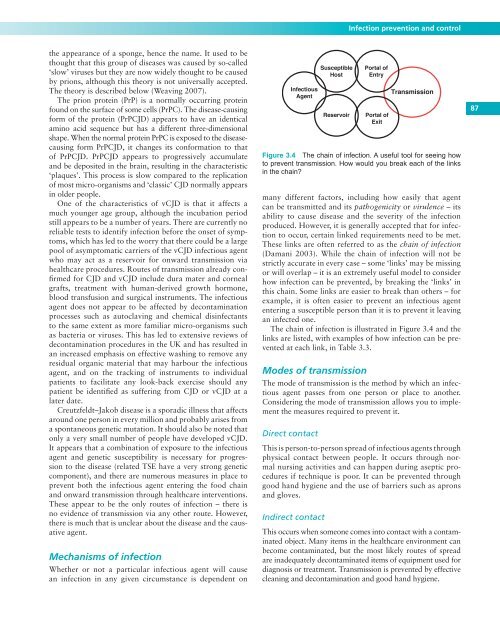Infection prevention and control - Royal Marsden Manual of Clinical ...
Infection prevention and control - Royal Marsden Manual of Clinical ...
Infection prevention and control - Royal Marsden Manual of Clinical ...
You also want an ePaper? Increase the reach of your titles
YUMPU automatically turns print PDFs into web optimized ePapers that Google loves.
the appearance <strong>of</strong> a sponge, hence the name. It used to be<br />
thought that this group <strong>of</strong> diseases was caused by so-called<br />
‘slow’ viruses but they are now widely thought to be caused<br />
by prions, although this theory is not universally accepted.<br />
The theory is described below ( Weaving 2007 ).<br />
The prion protein (PrP) is a normally occurring protein<br />
found on the surface <strong>of</strong> some cells (PrPC). The disease-causing<br />
form <strong>of</strong> the protein (PrPCJD) appears to have an identical<br />
amino acid sequence but has a different three-dimensional<br />
shape. When the normal protein PrPC is exposed to the diseasecausing<br />
form PrPCJD, it changes its conformation to that<br />
<strong>of</strong> PrPCJD. PrPCJD appears to progressively accumulate<br />
<strong>and</strong> be deposited in the brain, resulting in the characteristic<br />
‘plaques’. This process is slow compared to the replication<br />
<strong>of</strong> most micro-organisms <strong>and</strong> ‘classic’ CJD normally appears<br />
in older people.<br />
One <strong>of</strong> the characteristics <strong>of</strong> vCJD is that it affects a<br />
much younger age group, although the incubation period<br />
still appears to be a number <strong>of</strong> years. There are currently no<br />
reliable tests to identify infection before the onset <strong>of</strong> symptoms,<br />
which has led to the worry that there could be a large<br />
pool <strong>of</strong> asymptomatic carriers <strong>of</strong> the vCJD infectious agent<br />
who may act as a reservoir for onward transmission via<br />
healthcare procedures. Routes <strong>of</strong> transmission already confi<br />
rmed for CJD <strong>and</strong> vCJD include dura mater <strong>and</strong> corneal<br />
grafts, treatment with human-derived growth hormone,<br />
blood transfusion <strong>and</strong> surgical instruments. The infectious<br />
agent does not appear to be affected by decontamination<br />
processes such as autoclaving <strong>and</strong> chemical disinfectants<br />
to the same extent as more familiar micro-organisms such<br />
as bacteria or viruses. This has led to extensive reviews <strong>of</strong><br />
decontamination procedures in the UK <strong>and</strong> has resulted in<br />
an increased emphasis on effective washing to remove any<br />
residual organic material that may harbour the infectious<br />
agent, <strong>and</strong> on the tracking <strong>of</strong> instruments to individual<br />
patients to facilitate any look-back exercise should any<br />
patient be identifi ed as suffering from CJD or vCJD at a<br />
later date.<br />
Creutzfeldt–Jakob disease is a sporadic illness that affects<br />
around one person in every million <strong>and</strong> probably arises from<br />
a spontaneous genetic mutation. It should also be noted that<br />
only a very small number <strong>of</strong> people have developed vCJD.<br />
It appears that a combination <strong>of</strong> exposure to the infectious<br />
agent <strong>and</strong> genetic susceptibility is necessary for progression<br />
to the disease (related TSE have a very strong genetic<br />
component), <strong>and</strong> there are numerous measures in place to<br />
prevent both the infectious agent entering the food chain<br />
<strong>and</strong> onward transmission through healthcare interventions.<br />
These appear to be the only routes <strong>of</strong> infection – there is<br />
no evidence <strong>of</strong> transmission via any other route. However,<br />
there is much that is unclear about the disease <strong>and</strong> the causative<br />
agent.<br />
Mechanisms <strong>of</strong> infection<br />
Whether or not a particular infectious agent will cause<br />
an infection in any given circumstance is dependent on<br />
Infectious<br />
Agent<br />
<strong>Infection</strong> <strong>prevention</strong> <strong>and</strong> <strong>control</strong><br />
many different factors, including how easily that agent<br />
can be transmitted <strong>and</strong> its pathogenicity or virulence – its<br />
ability to cause disease <strong>and</strong> the severity <strong>of</strong> the infection<br />
produced. However, it is generally accepted that for infection<br />
to occur, certain linked requirements need to be met.<br />
These links are <strong>of</strong>ten referred to as the chain <strong>of</strong> infection<br />
( Damani 2003 ). While the chain <strong>of</strong> infection will not be<br />
strictly accurate in every case – some ‘links’ may be missing<br />
or will overlap – it is an extremely useful model to consider<br />
how infection can be prevented, by breaking the ‘links’ in<br />
this chain. Some links are easier to break than others – for<br />
example, it is <strong>of</strong>ten easier to prevent an infectious agent<br />
entering a susceptible person than it is to prevent it leaving<br />
an infected one.<br />
The chain <strong>of</strong> infection is illustrated in Figure 3.4 <strong>and</strong> the<br />
links are listed, with examples <strong>of</strong> how infection can be prevented<br />
at each link, in Table 3.3 .<br />
Modes <strong>of</strong> transmission<br />
The mode <strong>of</strong> transmission is the method by which an infectious<br />
agent passes from one person or place to another.<br />
Considering the mode <strong>of</strong> transmission allows you to implement<br />
the measures required to prevent it.<br />
Direct contact<br />
This is person-to-person spread <strong>of</strong> infectious agents through<br />
physical contact between people. It occurs through normal<br />
nursing activities <strong>and</strong> can happen during aseptic procedures<br />
if technique is poor. It can be prevented through<br />
good h<strong>and</strong> hygiene <strong>and</strong> the use <strong>of</strong> barriers such as aprons<br />
<strong>and</strong> gloves.<br />
Indirect contact<br />
Susceptible<br />
Host<br />
Portal <strong>of</strong><br />
Entry<br />
Reservoir Portal <strong>of</strong><br />
Exit<br />
Transmission<br />
Figure 3.4 The chain <strong>of</strong> infection. A useful tool for seeing how<br />
to prevent transmission. How would you break each <strong>of</strong> the links<br />
in the chain?<br />
This occurs when someone comes into contact with a contaminated<br />
object. Many items in the healthcare environment can<br />
become contaminated, but the most likely routes <strong>of</strong> spread<br />
are inadequately decontaminated items <strong>of</strong> equipment used for<br />
diagnosis or treatment. Transmission is prevented by effective<br />
cleaning <strong>and</strong> decontamination <strong>and</strong> good h<strong>and</strong> hygiene.<br />
87


